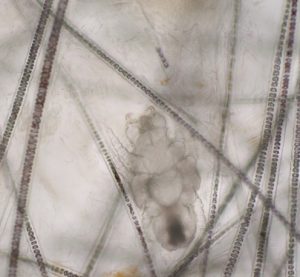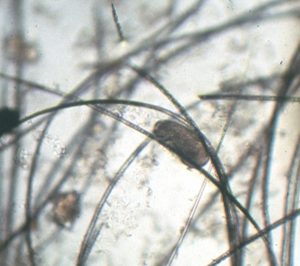3.7 Cheyletiellosis – Small Animals
Learning Objectives
- Know the domestic species that can have cheyletiellosis.
- Know the host specificity of the mites.
- Learn the classical clinical signs.
- Learn the sensitivity of multiple skin scrapings in the diagnosis of cheyletiellosis.
- Learn the treatment options and protocols.
- Learn if it is necessary to treat the environment.
-
General Considerations
- It is highly contagious!
- Cheyletiella mites affect dogs, cats, rabbits and people.
- In people, the condition manifests as very pruritic macular-papular lesions on the arms, trunk and buttocks. The lesions develop a central area of necrosis that is considered diagnostic.
- These mites are not associated with hair follicles (like Demodex mites) and do not burrow (like Sarcoptes and Notroedes mites).
- They move rapidly on the surface of the epidermis in pseudotunnels of epidermal debris.
- They are obligate parasites and spend their entire life cycle on the host.
- Mites usually die within 48 hours off the host but adult females have been maintained off the host for up to 10 days.
- Eggs are small and loosely attached to hairs (louse nits are much larger and are firmly cemented to hairs).
-
Cause
- Cheyletiella yasguri – dog.
- Cheyletiella blakei – cat.
- Cheyletiella parasitivorax – rabbit.
- Mites are not absolutely host specific.
- Mites are large and have diagnostic hook-like mouthparts. Eggs are attached loosely to the hair shaft.
-
Clinical Signs
- Pruritus can vary from mild to severe (usually not as intense as in sarcoptic and notoedric mange).
- Pruritus is primarily localized to the dorsum but it can occur anywhere on the trunk.
- The most common sign is dry, loose to slightly adhered, white scales, especially over the dorsum.


-
- Papules and crusts can also be present and may affect the tips of the pinnae.
- In cats, it can manifest as miliary dermatitis or symmetrical alopecia from excessive grooming (again, along dorsum).
- Cats can have pruritus without lesions.
- Cats can be asymptomatic carriers of the mites.
-
Diagnosis and Differential Diagnosis
- History:
- Pruritus before or at time of lesion development.
- Pruritus typically localized along the dorsum.
- No response to glucocorticoid therapy.
- Cats, dogs, rabbits and/or people in the household may be affected.
- People and/or other animals in the household are itching.
- Clinical Signs:
- Excessive scaling along the dorsum.
- Multiple skin scrapings:
- Mites and/or eggs are not easy to find.
- Multiple, broad skin scrapings (look for papules – they are the best lesions to scrape). Scrape until a small amount of capillary bleeding is obtained.
- An acetate tape (scotch tape) preparation can be used to collect mites. Place a drop of mineral oil on top of a glass slide (optional), the tape is placed sticky side down on top of the mineral oil or directly on the slide and evaluated under the microscope.
- Fecal flotation:
- Mites live on the skin surface and will be ingested, as will eggs, during grooming or itching.
- Because mites are not always found on skin scrapings or acetate tape preparations, treat it if you suspect it.
- History:


-
-
Differential Diagnoses:
- Dogs:
- Scaling – seborrheic dermatitis, endocrinopathies, pediculosis, poor nutrition and flea infestation.
- Pruritus – pruritic pyoderma, scabies, fleabite allergy, atopic dermatitis and food allergy.
- Cats:
- Scaling – any systemic disease where grooming activity is reduced.
- Pruritus – causes of symmetrical self-inflicted non-inflammatory alopecia, fleabite allergy, other allergies, differential diagnoses for military dermatitis.
- Dogs:
- Remember! Cheyletiellosis is a zoonotic disorder.
-

-
Treatment
- Ivermectin (Ivomec®; Merial): 300 µg/kg (0.3 mg/kg) given subcutaneously, three treatments 2 weeks apart, is very effective for dogs, cats and rabbits (not approved). Do not use avermectins in the following breeds: collie, Shetland sheepdog or its crosses; Australian shepherd, white Swiss shepherd, longhaired whippet, silken windhound, McNab, and Border collie. Breeds that the allele for the mutated ABCB1 gene has been detected but no homozygote for the mutated gene has been reported include the old English sheepdog, Waller, and the English shepherd. Ideally, avermectins should not be used in these breeds. Currently, there is a genetic test available at the Washington State University (https://vcpl.vetmed.wsu.edu/) that can identify the ABCB1-1 gene mutation associated with avermectins toxicity. This gene encodes for P-glycoprotein, which is responsible for pumping-out substances that cross the blood-brain barrier.
- Milbemycin oxime (Interceptor®; Elanco): 2 mg/kg once weekly for four treatments has been reported to be effective for the treatment of canine cheyletiellosis.
- Selamectin (Revolution®; Zoetis): Has been reported to be efficacious for the treatment of feline and canine cheyletiellosis with three treatments at 30-day intervals and in dogs when applied every 2 weeks for four treatments. In rabbits, it has been reported to be effective at 6.2 – 20 mg/kg one to three times with an interval of 2 to 4 weeks. Use the dosage recommended for heartworm prevention.
- A study reported that imidacloprid 10%/moxidectin 2.5% spot-on (Advantage Multi®; Bayer Health Care) at the dose of 0.1 mL/kg applied twice at 4-week intervals was very efficacious in treating cheyletiellosis in dogs. However, three treatments at 3-week intervals has been anecdotally reported as more efficacious. Improvement may only be noticed after the second or third treatment.
- Fipronil (Frontline® Spray; Merial): Spray to soak the skin and hair coat twice at 2-week intervals (dogs and cats). Do not use this product if doing a treatment trial because it has been associated with failure and you may erroneously rule out the disease if the treatment does not work. DO NOT USE FIPRONIL IN RABBITS. IT HAS BEEN ASSOCIATED WITH FATALITY.
- Isoxazolines – Fluralaner (Bravecto®; Merk) was successfully used to treat three dogs with cheyletiellosis. The oral dose used ranged from 27-49 mg/kg given once. It is likely that other isoxazolines will be also effective in treating cheyletiellosis in dogs and cats. Their safety profile is overall good; however, they can induce seizures. Avoid it in animals with a history of seizures.
- Treat all animals in the premises.
- The environment should be cleaned, sanitation improved, and the area thoroughly sprayed with a good residual insecticide every 2 weeks during the treatment period.
Important Facts
- Cheyletiellosis can be easily transmitted between dogs, cats, rabbits and people.
- Pruritus varies from mild to severe.
- Excessive scaling along the dorsum is the most common clinical sign.
- Clinical signs are variable in cats and the disease can present as miliary dermatitis, symmetrical self-inflicted non-inflammatory alopecia and the characteristic accumulation of dry white scales along the dorsum.
- Cats can be asymptomatic carriers.
- Perform multiple skin scrapings and look for papular lesions to scrape.
- Mites are not easily found on multiple skin scrapings or acetate tape preparations.
- If scrapings and acetate tape tests are negative, perform fecal flotation because mites can be ingested during grooming or itching.
- Fluralaner or other isoxazolines, ivermectin, milbemycin (dogs), selamectin, imidacloprid+moxidectin and fipronil are effective treatments.
References
Hansen-Jones C, Ronai T. Successful treatment of 3 naturally acquired cases of canine cheyletiellosis with fluralaner. Can Vet 2024; 65: 138-140.
Loft KE, Willesen JL. Efficacy of imidacloprid 10 per cent/moxidectin 2.5 per cent spot-on in the treatment of cheyletiellosis in dogs. Vet Rec 2007; 160:528-29.
McGarry JW. Recurrent infestation of a cat by Cheyletus eruditus (Shrank 1781). Vet Rec 1989; 125:18.
Miller WH, Griffin CE, Campbell KL. Small Animal Dermatology, 7th edn. St. Louis, MO: Elsevier, 2013; 300-303.
Mueller RS, Bettenay SV. Efficacy of selamectin in the treatment of canine cheyletiellosis. Vet Rec 2002; 151:773.
Paradis M, Vileneuve A. Efficacy of ivermectin against Cheyletiella yasguri infestation in dogs. Can Vet J 1988; 29:633.
Paradis M, Scott D, Vileneuve A. Efficacy of ivermectin against Cheyletiella blakei in cats. J Am Anim Hosp Assoc 1990; 26:125.
Scott DW, Miller WH, Griffin CE. Small Animal Dermatology. 5th edn. Philadelphia: W.B. Saunders Co., 1995; 412-417.

